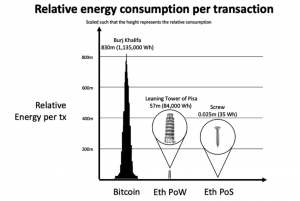
The path to green crypto
“As per usual the headlines surrounding the energy use of the crypto sector are misleading and one dimensional. Power consumption in crypto isn’t decided by Bitcoin alone. Unlike Bitcoin’s proof-of-work mechanism, other forward-thinking blockchain platforms are using proof-of-stake mechanisms.
The crypto market has garnered significant attention in the past year for its promising returns, but irresponsible energy use from non-renewable sources has turned potential investors away. They shouldn’t fret! The near future of this young asset class is going to be green. Signals by policymakers, investors, and thought leaders have reaffirmed and spurred commitment to creating a better and more sustainable system in crypto and the decentralized finance space.” – Marc LoPresti, Co-Managing Director, The Strategic Funds.
The United States rejoined the Paris Agreement in February, Elon Musk tweeted about Bitcoin’s mining emissions recently, and environmental, social, and corporate governance factors are important to both younger and older investors in this decade. It is clear that proof-of-stake is the New Green Deal for the future of finance. It merges the economic and political goals of the 21st century.
Even though always-on unused electronics consume more energy in the U.S., new virtual technologies like crypto want to offer the world profound innovation with progressive values. Ethereum, Bitcoin’s main competitor, plans to switch from proof-of-work to proof-of-stake at the end of 2021. At the moment, Ethereum mining consumes roughly as much electricity as Iceland. Vitalik Buterin, co-founder of Ethereum said the transition to proof-of-stake will make the network, “go from consuming the same energy as a medium-sized country to consuming the same energy as a village.” Proof-of-stake blockchains do not require miners to solve exceptionally complex puzzles to prove their work. The required processing power is very low. Environmental awareness has always been important to the crypto community.
https://hexus.net/tech/news/graphics/147827-ethereum-transition-proof-stake-will-slash-energy-use/
Another popular cryptocurrency called Cardano uses proof-of-stake. Ripple is another energy efficient cryptocurrency with strong environmental credentials. While one bitcoin transaction consumes an average 700 KWh of electricity, one Ripple transaction consumes just 0.0079 KWh. Ripple is 57,000 times more efficient than bitcoin. Another cryptocurrency called Nano has removed mining from its network and uses the consensus mechanism called Open Representative Voting. Despite the promising prospects related to proof-of-stake, some commentators believe proof-of-work is more secure. Existing and new proof-of-work blockchains will need to set up special rewards for miners who rely on clean energy and penalize miners with producing pollution. The blockchain is public and environmentally-minded networks can serve global goals without having to terminate their technological creations.
Not long ago, the Crypto Climate Accord (CCA) brought crypto-focused firms like Consensys, Coinshares, and Ripple together for the accelerated adoption of 100% renewably-powered blockchains by 2025. If leaders in crypto don’t adhere to implicit targets for lowered emissions, governments will target their industry directly. A proposed New York bill is going to assess the full environmental impact of crypto mining centers. The Securities and Exchange Commission asked for public input on climate change disclosures. Major payment platforms like PayPal, Stripe, Visa, and Square will most likely choose environmentally-aware cryptos. The industrial revolution of the 21st century is ramping up. There will be no unregulated coal burning that darkens the skies this time around. We have the building blocks for a better foundation for our future.

